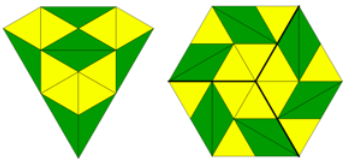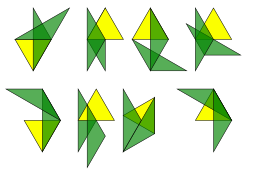Or search by topic
Number and algebra
Geometry and measure
Probability and statistics
Working mathematically
Advanced mathematics
For younger learners
Triangle Shapes



- Problem
- Getting Started
- Student Solutions
- Teachers' Resources
Triangle Shapes





Please do send in pictures of the shapes you make, whether they include overlaps or not.
Tell us what you notice about the shapes you've made.
Why do this problem?
This open-ended activity is designed to allow children to demonstrate their mathematical creativity. With the freedom to use the triangles in any of the three ways, pupils will develop their own criteria to satisfy. They may choose to focus on, for example, aspects of symmetry, or on repeated pattern, or on creating particular shapes, whether in outline or in overlap...
Possible approach
To start the group off, you could make, or print off, one of each suggested "type" of arrangement. It would be a good idea to have one of them partially completed so that you can ask the children how they might continue it and why. In discussing reasons for building up an arrangement in a particular way, you will be offering opportunities for the pupils to use language associated with shape
and possibly symmetry (amongst other things) and to share their ideas with each other. This will stimulate more ideas for making their own.
They could work in pairs, or individually, to make an arrangement of the triangles for themselves and as they work, move around the class, talking to them about how and why they have chosen that arrangement. Having cut out triangles available would be ideal - you could print off this sheet. You might like to ask one or two pupils to make
their design for the rest of the class to talk about. These two particular triangles are chosen as they share a common measurement and you could probe this a little with the children.
You may also like
Baked Bean Cans
Is there a best way to stack cans? What do different supermarkets do? How high can you safely stack the cans?

